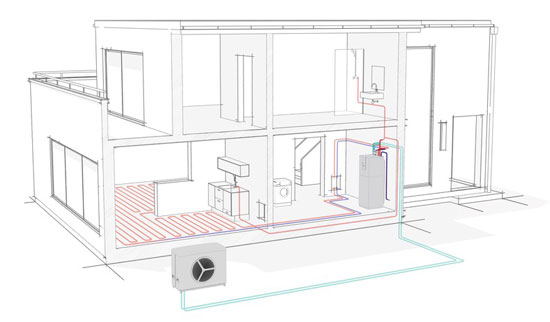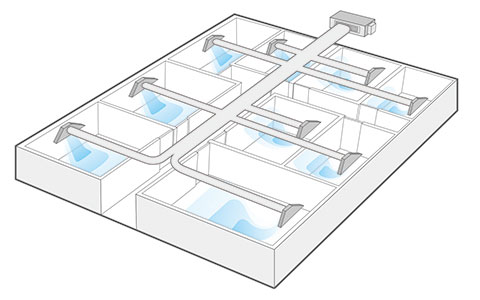
Hydronic heat pumps and air conditioners are similar. They are both electric, energy-efficient appliances. They typically deliver 3 to 5 times more energy in heating and cooling than the energy they consume from power. A reverse cycle air conditioner is an air-to-air heat pump in reverse cycle.
A hydronic heat pump is a bit more complicated because it converts heat from the outside air to hot water to provide radiant heating. Therefore, it is an air-to-water heat pump. In reverse cycle, it can provide cooling in summer.
Try holding your finger over a bicycle pump, the air (gas) gets very hot. This is what happens when you compress refrigerant after it has turned into a gas. The really useful thing about refrigerant used in most hydronic heat pumps is that it boils into a gas at around minus 48 degrees. Therefore, it can extract ”heat” from outside air well below zero degrees (C). This makes air sourced heat pumps ideal for southern and inland Australian climates.
Whilst both systems can provide heating and cooling, it is fair to say that hydronic air-to-water heat pumps are better at heating whilst air-to-air conditioners are better at cooling.
Radiant heating is a superior, more efficient and more comfortable form of heating. It is mainly delivered through underfloor hydronic circuits, radiator panels or towel rails. Hydronic heat pumps can also provide heating and chilled water cooling using fan coil convectors. Convectors work similarly to the indoor units of air conditioning systems, except they use chilled water instead of chilled refrigerant.
Advantages of using chilled water lines include easier plumbing and less use of refrigerants.

Conditioning Strategy
Hydronic heat pump systems are more expensive to install. Therefore, consider investing in a hydronic heat pump system for your main living rooms and reverse cycle air conditioners in bedrooms.
This dual approach works better if you have a two storey home with living rooms on the ground floor and bedrooms on the first floor. This makes use of rising, radiant warm air to minimise the need for reverse cycle heating from your air conditioner.
In summer, cool dehumidified air from your air conditioner falls to the ground floor. This minimises the need for cooling there. Moreover, well shaded, well insulated houses with ceiling fans may not require additional cooling at all on the ground floor. Contact us to check or discuss this.
Heat recovery ventilation could also be considered to reduce the need for air conditioning. This reduces the need for opening windows and therefore minimises unwanted heat transfer from windows.
Performance Improvements
Here are some suggestions to improve the performance of your heating & cooling systems:
- Clean the filters of your equipment regularly, at least prior to each heating and cooling season.
- Adjust your inside set temperature up and down with the seasons. This also improves your ability to adapt to changing weather.
- Install ceiling fans to reduce the effective temperature you feel by several degrees in summer. Then you can raise the set temperature and make operating cost savings.
- Zone off some rooms so you don’t need to heat or cool your whole house all the time.
- Improve thermal performance of your house.
- Browse electric energy-efficient product information and pricing: Hydrosol Shop
